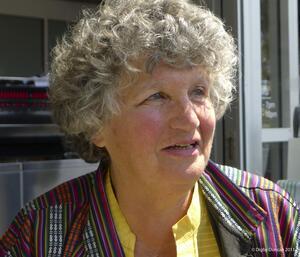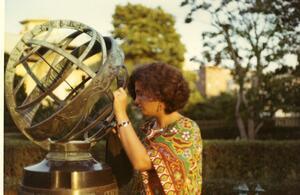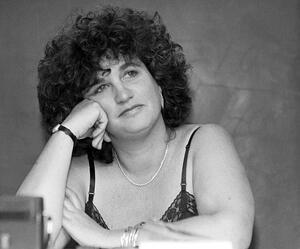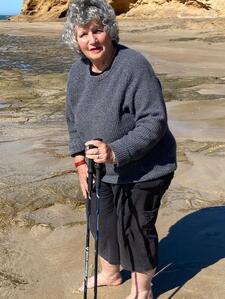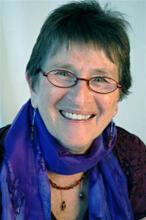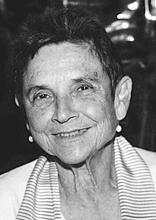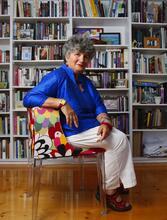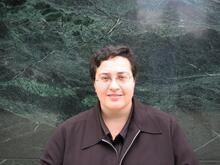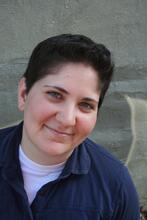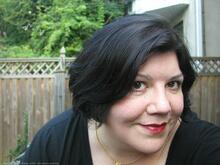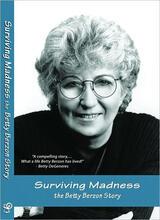Joan Nestle
Writer, activist, educator, and archivist Joan Nestle became involved in the 1960s in the Civil Rights Movement, as well as other grassroots movements, while also teaching Queens College. In the 1970s she helped found the Gay Academic Union, which advocated for gay members of the CUNY system. This led to Nestle co-founding the Lesbian Herstory Archives, now the largest lesbian archival collection in the world. In the late 1970s, Nestle began writing erotica and political essays, primarily about lesbian identity, sexuality, and history. Nestle particularly discussed butch and femme culture and identity, especially as informed by the working-class lesbian bar culture she was a part of in the 1950s. Her writing was targeted by the anti-pornography movement, leading Nestle to become a notable pro-sex activist.
Early Life
Joan Nestle was born on May 12, 1940, in the Bronx, and raised there and in Queens by her mother, Regina Nestle, who worked as a bookkeeper. Her father, Jonas, died six months before Joan was born, and she had one older brother. For a period of time, Nestle also lived with her aunt and uncle due to her family's precarious financial situation. Nestle graduated from Queens College, City University of New York, in 1963 and earned a master’s degree in English from New York University in 1968. She worked toward a doctorate for two years but obtained a university teaching job before completion and did not finish the degree.
As a teen and young adult, Nestle frequented the Sea Colony bar in Greenwich Village, about which she writes often in her essays on butch and femme bar culture of the 1950s. The Sea Colony was a popular bar for working-class lesbians at the time, and a place where Nestle came of age and found community. It was also her first exposure to the police violence and surveillance that came with being a lesbian. The Sea Colony was subject to frequent raids, and, since crossdressing was illegal in New York at the time, patrons needed to wear three articles of women’s clothing or risk being arrested for impersonating men.
In her essay “The Bathroom Line,” Nestle describes a policy at the Sea Colony that only one woman be allowed into the bathroom at a time in order to control what happened inside. This policy caused a long line to form outside, with everyone receiving an allotted amount of toilet paper before entering. This humiliation was a formative factor in Nestle’s activism; she writes, “Every time I took the fistful of toilet paper, I swore eventual liberation” (A Sturdy Yes of People, 361).
Activism and Teaching
In the 1960s, like many activist-minded cultural Jews in New York, Nestle participated in the civil rights movement through voter registration drives, sit-ins, and the 1965 Selma to Montgomery March. She was involved in other causes as well, such as protests against the HUAC (House Un-American Activities Committee) and the Vietnam War. These experiences provided a foundation for her emergent anti-racist, liberationist politics. Beginning in the 1970s, Nestle was also heavily involved in the women’s rights and gay liberation movements.
In 1964, Nestle began teaching writing at the Queens College SEEK (Search for Education, Elevation and Knowledge) program, which provides support for economically disadvantaged students. She remained at the program until her retirement three decades later. In 1972, she and several other CUNY employees founded the Gay Academic Union (GAU), which advocated for gay and lesbian students and employees of the CUNY system, as well as for gay scholarship and inclusion in CUNY courses. As the decade unfolded and feminist and gay and lesbian activism intensified, Nestle engaged in multiple struggles for women’s and gay liberation as an organizer, activist, writer, and speaker.
Over the course of her career Nestle has spoken at conferences, rallies, and other events, including the 1997 SUNY-New Paltz conference on women’s sexuality, the 2011 Lesbian Lives Conference in Brighton, England, and the first Kessler Lecture for the CUNY Center for Lesbian and Gay Studies in 1992. The lecture, a compilation of oral histories documenting the life of Black lesbian activist Mabel Hampton, is published as an essay in several of Nestle’s anthologies and reflects on the complex histories between African-American and Jewish women. Nestle has written often about her participation in the 1982 Barnard Conference on Feminism and Sexuality, which became embroiled in controversy because of its open discussions of sexuality and desire. The conflict only increased its organizers’ determination to continue the event.
Lesbian Herstory Archives
In 1973, Nestle helped form a separate meeting group for women within the GAU. This group included other prominent lesbian scholars, community leaders, and activists who subscribed to a wide variety of views on feminism, gay liberation, and other issues. In 1974, members formed the idea for the Lesbian Herstory Archives, a grassroots archive that attempted to develop a stronger sense of lesbian history, memory, and culture, concepts that Nestle and her colleagues found precarious and difficult to grasp in general, but especially for young lesbians.
As described in their first newsletter, the Archives aimed to collect any and all “records of lesbian lives and activities” (A Sturdy Yes of People, 367). This included items from notable lesbian figures and organizations, but also artifacts of lesbian life that were generally considered trash, such as letters and diaries. Through these items, the Archives hoped to create a “people’s history,” something previously denied them by previous archivists and historians. They also hoped that the Archives would encourage lesbians to begin to more actively document their experiences, rather than disposing of or even destroying evidence of their existence as was common at the time.
Nestle emphasized the importance of the Archives not becoming, in her words, “a handpicked collection of respectable lesbian role models” (A Sturdy Yes of People, 369). She accepted materials such as lesbian pornography, diaries and costumes from lesbian prostitutes and strippers, and other items some saw as controversial. Nestle felt strongly that excluding these items and adhering too strongly to the standards of one specific time period would cause the Archives to not fully capture the complexities of lesbian life, thus not providing accurate materials to future generations.
The Archives released their first newsletter in 1975 and began operation out of the Manhattan apartment Nestle shared with her then-partner, co-founder Deborah Edel. In the first few years of operation, Nestle, Edel, and their colleagues focused on building connections with other gay and lesbian organizations, bringing bags full of items to classrooms, festivals, bars, and other places where they were invited to speak. They visited used item sales to search for lesbian novels and other memorabilia and encouraged contributors to find and send in objects from trash heaps. Work at the Archives was, and still is, primarily volunteer-based. The organization held regular volunteer work hours, as well as community events such as film screenings, talks, and other opportunities for lesbians to present their work. Nestle was also known for hosting salons and public readings, which she often did in a signature black slip. In the late 1970s, Edel moved out of the apartment and Nestle remained; the Archives remained in her home until 1993, when they were moved to a new location in Brooklyn. Today, the Archives are the largest lesbian collection in the world, home to tens of thousands of items including photographs, buttons, clothing, posters, film footage, books, artwork, periodicals, and other personal items.
Essays and Writing
Nestle began writing in the late 1970s and has published personal essays as well as writings on contemporary social and political topics. Similar to her approach with the Archives, Nestle often uses specific personal stories to reflect on and explore larger topics and ideas. She is largely known for her erotic writing, as well as essays that discuss desire, sexuality, and sex work and their importance in understanding lesbian history and culture. Nestle’s writing also often discusses the butch and femme bar culture of the 1950s, which she herself experienced.
Much of Nestle’s overtly political writing is in response to the feminist anti-pornography movement, which viewed pornography and prostitution as inherently harmful to women. Nestle herself had received backlash from the movement for her erotic writing and discussions of butch and femme relationships. In 1981, for example, a publication that had accepted a short story by Nestle was forced to choose between dropping the story or finding a new printer because a typesetter had found its material “pornographic.” Members of groups like Women Against Pornography also contacted Nestle’s colleagues to warn them about her “deviant” views on sex and sexuality.
Nestle condemned the anti-pornography movement for viewing certain lesbians as less acceptable than others, threatening sex workers, writers of erotica, and butch and femme lesbians in the name of appearing respectable. She subsequently became a notable sex-positive activist and incorporated these values into her work. In “Lesbians and Prostitutes: An Historical Sisterhood,” for example, Nestle emphasizes the agency of female sex workers and argues that, like lesbians, they have been deprived of senses of history and peoplehood. She also notes the frequent overlap between these two groups.
Many of Nestle’s essays also recontextualize contemporary views of butch and femme identity. Many anti-pornography feminists believed that butch and femme identities were a regressive way of maintaining heteronormative roles and power dynamics in lesbian relationships. Nestle argued against this idea and asserted that rejecting butch and femme culture meant rejecting an important part of lesbian identity and history. Butch and femme lesbians encompassed a wide range of identities and sexuality, she argued, and did not aim to model themselves after heterosexual couples; in fact, their appearances made their identities more obviously visible and signaled their “erotic independence” (A Sturdy Yes of People, 109).
One of Nestle’s best-known essays, “Esther’s Story,” tells the story of a one-night stand with a “passing” woman, a term used to describe a lesbian who generally “passes” as a man in the straight world. Published in 1981, “Esther’s Story” is an often-cited example of Nestle’s erotic writing, as well as of her depictions of butch and femme culture and relationships. Two decades later, when Nestle was asked to speak at an event for a transgender organization, she published a sequel, “On Rereading ‘Esther’s Story,’” that acknowledged her simplification of Esther’s gender identity. In this essay, Nestle stresses the importance of continuously challenging understandings of gender and emphasizes that definitions of “butch” and “femme” are always evolving. Nestle is now cited as a key figure in redefining, and destigmatizing, butch and femme identity. The 1992 anthology The Persistent Desire: A Femme-Butch Reader, which Nestle edited, is a particularly influential text that articulates how sexuality and identity can change over time and yet stay persistent in many ways.
Nestle’s work also frequently discusses family, in particular her relationship with her mother, as well as Jewish identity. Her autobiographical essay “A Restricted Country,” for example, follows Nestle, her mother, and her brother on a trip during her childhood in the 1950s to a ranch in Arizona that doesn’t allow Jewish guests. The trip caused Nestle to more fully understand antisemitism as well as her own Jewishness.
Nestle’s writing often reflects a culturally Jewish standpoint, and she considers her work to be embedded in her working-class Jewish background. Her essay “A Jew From New York…in Melbourne” discusses Jewishness more explicitly as it documents her efforts to find Jewish community in Australia and the connections she forms with Jews there. During this time she becomes friends with a member of a local Jewish lesbian group, the Jewish Lesbian Group of Victoria, who translated one of her essays into Yiddish. The essay itself appears in an anthology published by the group, Jewish Lesbians Down Under. Nestle identifies as an “anti-occupation Jew” and has been involved with activist groups supporting the Palestinian people and efforts at peace in the Middle East such as Women in Black.
Later Career
Nestle retired from Queens College in 1995 due to colorectal cancer and was diagnosed with breast cancer in 2001. She remained in New York City until 2002, when she moved to Australia with her partner Diane Otto, a professor at the University of Melbourne. Nestle and Otto met through a mutual friend in 1998 and maintained a relationship from across the world until Nestle’s move. Nestle currently serves as a fellow advising graduate students at the University of Melbourne, and works with the Australian Lesbian and Gay Archives (ALGA) and the Australian Jewish Democratic Society (AJDS).
Nestle’s essays have been published in three anthologies: A Restricted Country in 1988, A Fragile Union in 1998, and A Sturdy Yes of People in 2023. The 2002 documentary “Hand on the Pulse,” directed by Joyce Warshow, depicts Nestle’s life and work.
Selected Works by Joan Nestle
A Restricted Country: Essays and Short Stories. Ithaca, NY: Firebrand Books, 1988.
A Fragile Union: New and Selected Writings. San Francisco: Cleis Press, 1998.
A Sturdy Yes of People: Selected Writings. Dover, FL: Sinister Wisdom, 2022.
As Editor:
The Persistent Desire: A Femme-Butch Reader. Boston: Alyson Publications, 1992.
Women on Women: An Anthology of Lesbian Short Fiction. New York: Plume, 1993. Co-edited with Naomi Holoch.
Sister and Brother: Lesbians and Gay Men Write about Their Lives Together. San Francisco: HarperSanFrancisco, 1994. Co-edited with John Preston.
Genderqueer: Voices from Beyond the Binary. New York: Alyson Books, 2002. Co-edited with Clare Howell and Riki Wilchins.
At-Home With Joan. Joan Nestle, 2000, https://www.joannestle.com/
Lesbian Herstory Archives. Lesbian Herstory Archives, https://lesbianherstoryarchives.org.
Nestle, Joan. “A Jew From New York…in Melbourne.” Jewish Lesbians Down Under. Victoria, Australia: Jewish Lesbian Group of Victoria, 1998, https://jlgvic.org/pdf/Jew%20from%20NY.pdf.
Nestle, Joan. “Joan Nestle: Sixty Years of Dissent and Desire.” By Dylan Foley. The Last Bohemians Blog, 2020, https://lastbohemians.blogspot.com/2020/10/joan-nestle-sixty-years-of-dissent-and.html.
Nestle, Joan. A Sturdy Yes of People: Selected Writings. Dover, FL: Sinister Wisdom, 2022.
“Sea Colony.” NYC LGBT Historic Sites Project. NYC LGBT Historic Sites Project, 2023, https://www.nyclgbtsites.org/site/sea-colony.

